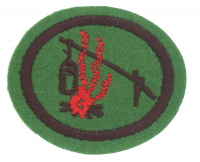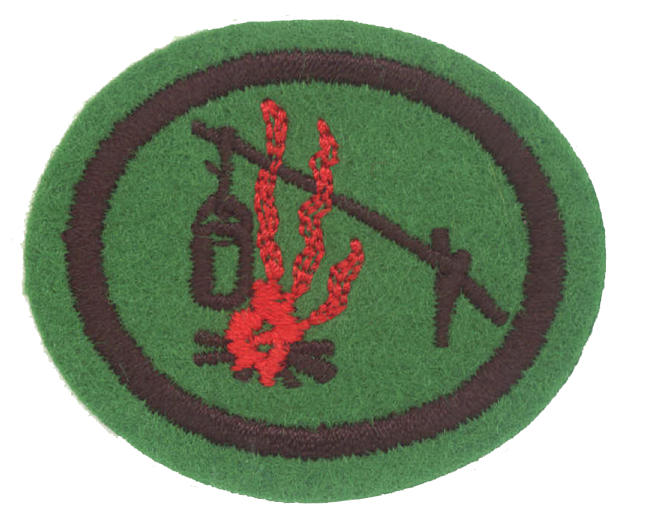Especialidades JA/Fogatas y cocina al aire libre/Respuestas 2
Nivel de destreza
2
Año
1956
Version
06.12.2025
Autoridad de aprobación
Asociación General
1
Fogata Cazador
Adventist Youth Honors Answer Book/Camping/Fire/Hunters/es
Fogata Reflector
Adventist Youth Honors Answer Book/Camping/Fire/Reflector/es
Fogata Estrella
Adventist Youth Honors Answer Book/Camping/Fire/Star/es
Fogata Tipi
Adventist Youth Honors Answer Book/Camping/Fire/Teepee/es
Fogata Cabina de Troncos
Adventist Youth Honors Answer Book/Camping/Fire/Log Cabin/es
Fogata de Consejo
Adventist Youth Honors Answer Book/Camping/Fire/Council/es
2
3
Un fuego necesita tres cosas para quemar: combustible, aire y calor. Debe prestar atención a los tres para construir un incendio exitoso.
Combustible
El combustible se clasifica en tres grupos: yesca, leña y combustible.
La yesca es algo ligero y esponjoso que es fácil de encender. Puede estar hecho de muchos tipos diferentes de material, incluyendo pasto seco, agujas de pino muerto, virutas de madera, plumas de ave, pelusas de bolsillo, papel, semillas de algodoncillo, etc. La clave de la yesca es que debe estar seca, delgada y rala. La yesca se coloca primero y luego está rodeada con leña.
Leña es un poco más grande que la yesca. Los palitos del tamaño de un lápiz son una excelente leña, pero si toda la leña es de ese tamaño, necesitará mucha. Ordénelo por diámetro y apile las cosas más pequeñas sobre la yesca primero, agregando pedazos progresivamente más grandes encima. Puede organizarlo en un tipi, cabaña de troncos o incluso en un arreglo de poste de cumbrera y viga. A medida que construye la pila de leña, agregue piezas cada vez más grandes, pero no agregue nada con un diámetro mayor a 1.5 pulgadas, si es más grande que eso, pasará a la siguiente categoría de tamaño. Apilar la leña es quizás el aspecto más importante para construir un fuego exitoso. Si se apila demasiado, el aire no puede circular y entregar calor desde la yesca y no se encenderá. Si no tiene suficiente, se quemará antes de encender el combustible principal.
El combustible es lo más grande que se va a quemar, aunque para acampar, no debe ser más grande que seis pulgadas (15.24 cm) de diámetro. Más grande que eso y usted se levantará toda la noche para cuidarlo, o se encontrará apagándolo antes de irse a acostar. Es mucho mejor quemar todo su combustible por completo.
Aire
Puede parecer que no necesita hacer nada para asegurarse de que su fuego tenga un buen suministro de aire; después de todo, el aire está a nuestro alrededor. Pero un incendio necesita «mucho» aire y la forma en que se apila el combustible puede afectar esto en gran medida. No apile el combustible demasiado apretado. La leña debe apilarse de manera que los espacios entre las piezas sean iguales al ancho de las piezas (en promedio). En otras palabras, la pila de leña debe tener aproximadamente un 50% de aire y un 50% de madera en volumen. Estos espacios permitirán que las llamas se interpongan en el medio y quemen «todas» las astillas, encendiendo así los troncos de combustible más grandes. Cuando agregue leña al fuego, asegúrese de que haya al menos un espacio de una pulgada entre cada pieza. De lo contrario, cortará el suministro de aire y el fuego se apagará sin quemar todo el combustible.
Calor
Inicialmente, se agrega calor al combustible y al aire con un fósforo, un encendedor u otro dispositivo para encender fuego. Si utiliza técnicas de encender primitivas, la yesca se enciende primero y luego se transfiere a la pila de leña. El calor se transfiere del fósforo (o chispa) a la yesca, y luego de la yesca a la leña, de la leña al combustible principal y, finalmente, el calor del combustible principal será suficiente para mantener el fuego, encendiendo más combustible (y a veces secándolo) a medida que se agrega. Para que el fuego se apague, separe los troncos para que su calor se extienda. Para quemar todo el combustible, siga empujando los extremos no quemados de los troncos hacia el centro para concentrar el calor (pero mantenga «algo» de distancia entre los troncos para permitir la entrada de aire).
4
Again, the secret to keeping a fire going after it is lit, is to stack the fuel progressively from smallest to largest. Be sure you have enough tinder to ignite the kindling, and enough kindling to ignite the main fuel. Keep the stack loose enough to allow air to circulate, but tight enough to allow the heat to reach the next layer in the pile. Stack the kindling atop the tinder and have the main fuel ready to go - but do not add it yet. Light the tinder. As soon as you have a good flame, start adding the main fuel to the fire. Add it in an orderly fashion, using one of the techniques detailed in requirement 1 (the council fire works particularly well for this, as it is easy to lay it and the fuel is positioned directly over the kindling).
5
6
Adventist Youth Honors Answer Book/Camping/Cutting firewood/es
Adventist Youth Honors Answer Book/Camping/Splitting firewood/es
7
8
Simmering
Adventist Youth Honors Answer Book/Camping/Simmering
Boiling
Adventist Youth Honors Answer Book/Camping/Boiling
Frying
Foods that are prepared by frying include
- Pancakes
- Scrambled or fried eggs
- French toast
- Vegetarian sausages
- Veggie burgers
- Grilled cheese sandwiches
Bread on a stick
Adventist Youth Honors Answer Book/Camping/Bread on a stick
Aluminum foil baking
Adventist Youth Honors Answer Book/Camping/Aluminum foil baking
Reflector oven baking
Adventist Youth Honors Answer Book/Camping/Reflector oven baking
9
10
11
12
- a. Un buen desayuno, almuerzo, cena para una caminata donde el poco peso es importante. La comida no debe ser cocinada, pero debe ser nutritiva.
- b. Las cinco comidas restantes podrán estar compuestas por cualquier clase de comida: enlatados, frescos, congelados o deshidratados. Una de las cinco comidas debe ser hecha en una olla.
Buena nutrición
Los grupos de alimentos están definidos por el USDA (Departamento de Agricultura de los Estados Unidos) en MiPlato. La cantidad de cada grupo de alimentos que necesita un individuo varía según la edad, el sexo y la cantidad de actividad física. El siguiente cuadro muestra la cantidad recomendada de cada grupo para personas de edad de Conquistadores y activos (y es seguro asumir que estarán bastante activos en un campamento).
Adventist Youth Honors Answer Book/Food pyramid chart/es
Comida para la senda
Los sándwiches, la mezcla de frutas secas y la fruta son una buena combinación de alimentos que no requieren cocción. La leche en polvo es otra opción que tampoco requiere cocción, igual como cualquiera de los batidos de pérdida de peso. Sin embargo, realmente quiere llevar algo con muchas calorías. Los maníes y otras nueces sin cáscara también son buenos ya que son altos en calorías (que se necesitan en una caminata).
Comida de una olla
Adventist Youth Honors Answer Book/Camping/One-pot meal/es
13
The most obvious things on this list will be the ingredients for the meals - but don't stop there! Inexperienced campers have been known to bring canned foods, but no can openers. An industrious individual may find a way to open a can without one, but it is so much easier (and safer) to open a can with the proper tool. You will also need proper cookware for these meals. A pot will certainly be required (for the one-pot meal), but you will also need something to stir and serve the food with, as well as a plate or bowl from which to eat. Don't forget flatware. If you're planning to cook over an open fire, you'll need something to light it with as well as the needed fire safety gear (fire extinguisher, or a bucket to fill with water at the camp site). Otherwise, you will need a camp stove and fuel. Other items may include a cutting board and a sharp kitchen knife, a Dutch oven, pot holders, and a skillet. But don't just blindly pack all of these items - think first. If you will not need a Dutch oven, leave it behind. Imagine yourself going through all the steps to cook the food - with as much detail as you can - and note what items you'll need.
14
Food safety
There are two key elements to handling food safely: cleanliness, and freshness. Wash your hands before and during cooking. Be aware of the "danger zone" for food - fresh food above 4°C![]() and below 60°C
and below 60°C![]() is in danger of spoiling. Keep it in a cooler, make sure the lid stays on, and make sure it stays cold inside. Use fresh foods early in the camp out, and do not rely on a cooler for more than a day and a half. When all the ice in a cooler has melted, the food inside should no longer be used.
is in danger of spoiling. Keep it in a cooler, make sure the lid stays on, and make sure it stays cold inside. Use fresh foods early in the camp out, and do not rely on a cooler for more than a day and a half. When all the ice in a cooler has melted, the food inside should no longer be used.
Trash disposal
Try not to make more food than your group will eat. Dispose of any leftover food as required by a campground, or store it in a cooler. Under no circumstances should food be brought into a tent where people intend to sleep. All food needs to be put away as soon as possible and it needs to be kept out of the reach of wild animals. Skunks, raccoons, and bears can be very clever when it comes to getting food. Suspend your food 10 feet above the ground and at least five feet away from a tree trunk.
Wash your gear
As soon as the meal is over, wash all the dishes and kitchen utensils. Wild critters will be happy to drag your spatula from your kitchen and lick it clean for you, but they rarely return such items, nor do they clean them satisfactorily.
It is a good idea to number all the plates, forks, bowls, knives, spoons, and cups your group owns, and then keep like-numbered items in a hosiery bag. Each camper is assigned a number, and each camper is responsible to clean his own eating gear. If you find an abandoned bowl on a picnic table, it is a simple matter to check the number, determine the owner, and convince him to do his part. Once the dishes are washed, they are returned to the hosiery bag and hung on a line to dry. It is also a good idea to number the clothespins with which the hosiery bags are hung, and hang them in order. This is not a much trouble is it sounds, and makes finding your own dish set a snap.
Asigne un equipo de cocina para cada comida y haga que ese equipo cocine la comida y limpie la cocina. Opcionalmente, puede usar dos equipos para esto, uno haciendo la cocción y el otro haciendo la limpieza.
Referencias


